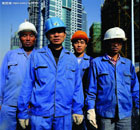Top Biz News
A look at carbon-right disputes
By Zhang Monan (China Daily)
Updated: 2009-12-22 07:50
 |
Large Medium Small |
Climate change is an issue that concerns the common interest of the international community, regardless of a country's development status. However, it's regrettably ironic that the West still approached climate change at the Copenhagen summit with the power politics of a Cold War mindset.
With the absoluteness of "global warming" being replaced by the conceptual ambiguity of "climate change", it has turned out that the forces pushing the world toward a climate problem are not generated from the catastrophic scenario of "global warming" drawn by scientists, but from the wrestling over a carbon-credit standard system and carbon rights that lie behind it.
The Copenhagen talks appeared to focus on promises of emission reduction by developed and developing countries. But it was actually about the distribution of development rights, leadership and emission reduction resources in the international community. Energy efficiency, the right to reduce carbon emissions, has become an asset for countries to fight for during the last 10 years. The Kyoto Protocol, together with the post-Kyoto system, can be regarded as an international agreement endowing carbon dioxide emission rights with a completely new currency issuing system. The basic framework of a "carbon-credit standard system" that boasts the comprehensive advantages of commodity and currency standards has been established. The carbon standard has gradually evolved into a kind of sovereignty productivity, operating global wealth and redefining international division of labor.
As for the commodity standard, huge market scale has formed the supplying capacity of a carbon currency. Statistics from the World Bank indicate that the average growth rate of carbon trading between 2006 and 2008 exceeded 320 percent. The gross carbon trade in 2008 hit 4.8 billion tons, or $126 billion in all, more than 100 times that of 2004. It has been calculated that the annual global average trade of carbon dioxide is between 700 million and 1.3 billion tons, making a mega international carbon trade market with an annual turnover between $14 billion and $65 billion, which is likely to become the largest commodity market in the world within five years.
As far as a currency standard is concerned, binding carbon credits with currency may probably settle the reconstruction of the international currency system. The combination of economic activity and energy trading proves an important factor in deciding the status of a country's currency, controlling the power of the most important energy in the world or whether the country has international pricing rights for the specific energy concerned. This has become the main motivator pushing a country's rise and promoting its currency to become an international currency.
The history of international currency demonstrates that the growth of a certain country's currency into an international currency, or even a key currency, should always follow the routine from pricing settlement currency to reserve currency and finally anchor currency. All of the main players in carbon trading are striving to make their own currency the lead one in the energy market. The euro is currently the main pricing settlement currency in the markets for carbon spots and carbon derivatives. Japan is also passionately preparing to turn the yen into the third pricing settlement currency in carbon trading. The strategic advantages of the United States have been dented. The dominant status of the US dollar in the international currency system is being confronted with serious challenges. Therefore, the US is looking for a new direction for the dollar as it has been losing its credit advantage of being the global reserve currency. Moreover, Uncle Sam has been actively involved in constructing a carbon-rights market, snapping up and stocking up carbon dioxide emission rights to once again forge a new hegemony system.
Besides, developed countries are building the basic parts of a global carbon-trade market for carbon emission rights and carbon-trade currency. Through the penetration of financial capital, Western countries, in order to occupy the commanding heights in the future global carbon-trade market, are dedicated to establishing a carbon financial system chiefly supported by a set of financial facilities including direct investing and financing, bank loans, carbon index trading, carbon options and futures.
China is the most capable potential supplier in the low carbon industry chain, but is not a pricing party. Possessing the richest carbon emission resources, China has also become the largest carbon emission cutter under the CDM mechanism. As indicated by statistics from the United Nations Development Program, accounting for over 58 percent of global reductions among all registered emission reduction volume, China is the No 1 in terms of both registered numbers and absolute annual emission reduction among all countries.
However, the renminbi has not become the pricing and settlement currency of carbon trading yet, which saddles China with austere handicaps for its lack of pricing rights in global carbon finance.
With comparatively low carbon capital efficiency, China is still short of basic carbon trade regulations, sites and platforms, let alone support for carbon finance and services. Mismatch between the development of its carbon financial system and the presumably great potential of a carbon market restricts China to a lower position in the trade chain of carbon finance.
| ||||
It is almost impossible for the West to compromise with the developing world, for it is playing a lead role in the international arena by using power politics. Even if a global agreement is hammered out, it may be another unbalanced Bretton Woods System. Copenhagen is not a finishing point, but a starting line. All developing countries, including China, have to face dozens of challenges, among which is how to break the West-led carbon emission reduction system to give a push to the construction of a balanced global carbon emission reduction and carbon financial system.
The author is an economics researcher with the State Information Center.













